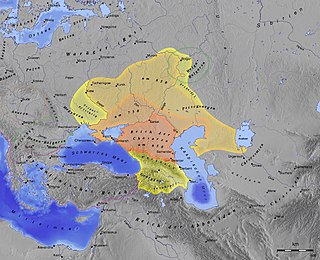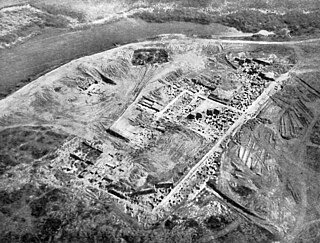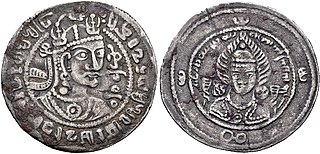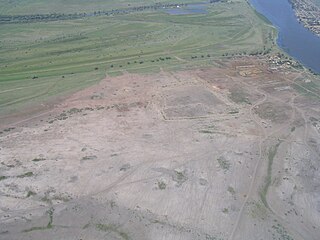
The Khazars were a nomadic Turkic people that, in the late 6th-century CE, established a major commercial empire covering the southeastern section of modern European Russia, southern Ukraine, Crimea, and Kazakhstan. They created what for its duration was the most powerful polity to emerge from the break-up of the Western Turkic Khaganate. Astride a major artery of commerce between Eastern Europe and Southwestern Asia, Khazaria became one of the foremost trading empires of the early medieval world, commanding the western marches of the Silk Road and playing a key commercial role as a crossroad between China, the Middle East and Kievan Rus'. For some three centuries the Khazars dominated the vast area extending from the Volga-Don steppes to the eastern Crimea and the northern Caucasus.

Sarkel was a large limestone-and-brick fortress in what is now Rostov Oblast of Russia, on the left bank of the lower Don River.

Samandar was a city in Khazaria, on the western shore of the Caspian Sea, in what is now Daghestan. At some later date, it may have been moved inland to some areas near the present-day village of Shelkovskaya in the modern Chechen Republic.

Balanjar was a medieval city located in the North Caucasus region, between the cities of Derbent and Samandar, probably on the lower Sulak River. It flourished between the seventh and tenth centuries. The legendary founder of Balanjar, according to the Persian and Kurdish chroniclers Ibn al-Faqih and Abu al-Fida, was named Balanjar ibn Yafith.

The Volga is the longest river in Europe. Situated in Russia, it flows through Central Russia to Southern Russia and into the Caspian Sea. The Volga has a length of 3,531 km (2,194 mi), and a catchment area of 1,360,000 km2 (530,000 sq mi). It is also Europe's largest river in terms of average discharge at delta – between 8,000 m3/s (280,000 cu ft/s) and 8,500 m3/s (300,000 cu ft/s) – and of drainage basin. It is widely regarded as the national river of Russia. The hypothetical old Russian state, the Rus' Khaganate, arose along the Volga c. 830 AD. Historically, the river served as an important meeting place of various Eurasian civilizations.
The Khazar Correspondence is a set of documents, which are alleged to date from the 950s or 960s, and to be letters between Hasdai ibn Shaprut, foreign secretary to the Caliph of Cordoba, and Joseph Khagan of the Khazars. The Correspondence is one of only a few documents attributed to a Khazar author, and potentially one of only a small number of primary sources on Khazar history.

Georgius Tzul was a Khazar warlord against whom the Byzantine Empire and Mstislav of Tmutarakan launched a joint expedition in 1016.
Saqsin was a medieval city that flourished from the eleventh to the thirteenth centuries. It was situated in the Volga Delta, or in the Lower Volga region, and was known in pre-Mongol times as Saksin-Bolgar, which in Mongol times became Sarai Batu. It was mentioned by the Arab geographer al-Gharnati and the Persian Qazwini, among others, and recorded as "the land of the Saksins" in the report of Friar Benedict of Poland about the 1246 trip of Giovanni da Pian del Carpine through the camp of Mongol prince Batu Khan on the shores of the Volga. S.A. Pletneva locates Saksin between present Volgograd and Akhtubinsk.
Arsiyah was the name used for a group of Muslim mercenaries in the service of the Khazar Khaganate. Whether the Arsiyah were a single tribe or composed of Muslims from a number of different tribes is unclear. Also unclear is their origin; many historians regard them as deriving from Khwarazm, but some scholars point to the fact that "As" is the Turkic term for Alans and believe that the Arsiyah were Alanic in origin. Other scholars derive the name from Iranian Auruša (white).
Joseph ben Aaron was king of the Khazars during the 950s and 960s. Joseph was the son of Aaron II, a Khazar ruler who defeated a Byzantine-inspired war against Khazaria on numerous fronts. Joseph's wife was the daughter of the king of the Alans.
Khagan Bek is the title used by the bek (generalissimo) of the Khazars.
A purported Khazar ruler of the late tenth century CE who ruled over a Khazar successor-state in the Taman region. David is mentioned in a single document dated AM 4746 which contains a reference to "our lord David, Prince of the Khazars, who lives in Taman." The document in question is of uncertain authenticity, as it passed through the hands of Abraham Firkovich, who on occasion forged documents and inscriptions. Dan Shapira expressed certainty that the document is a forgery by Firkovich and his viewpoint was adopted by other scholars who cited him including Michael Toch and Kevin Brook.

An elteber was a client king of an autonomous but tributary tribe or polity in the hierarchy of the Turkic khaganates including Khazar Khaganate.
Baliqchi was a supposed military title used by the Khazar Khaganate. The main piece of support for the term's existence is the historiography of Theophanes the Confessor, which mention a governor of Phanagoria during Justinian II's 705 CE excursion into Khazaria by the name of Balgitzin – which has sometimes been as a Greek corruption of the title baliqchi, but this is unclear. If Balgitzin can be associated with baliqchi, then it may mean "[an executer of a labour/issue] pertaining to a walled town/stronghold", as balık in Old Turkic means "walled town, stronghold", therefore affording a title or a common name for a townwall guardian. Other meanings for baliqchi have been proposed, such as "fisherman", which might imply a connection to a naval force.
The Battle of Marj Ardabil or the Battle of Ardabil was fought on the plains surrounding the city of Ardabil in northwestern Iran in AD 730. A Khazar army led by Barjik, the son of the Khazar khagan, invaded the Umayyad provinces of Jibal and Iranian Azerbaijan in retaliation for Caliphate attacks on Khazaria during the course of the decades-long Khazar-Arab War of the early 8th century.
Kazarki was a Khazar settlement. It was located west of the Volga River and north of Sarkel, from roughly the 7th through the 10th centuries CE. The area around it was known in early Russian sources as Volost' Kazarskaya, or "Khazar region."

The Caspian expeditions of the Rus' were military raids undertaken by the Rus' between the late 9th century and c. 1041 on the Caspian Sea shores, of what are nowadays Iran, Dagestan, and Azerbaijan. Initially, the Rus' appeared in Serkland in the 9th century travelling as merchants along the Volga trade route, selling furs, honey, and slaves. The first small-scale Viking raids took place in the late 9th and early 10th century. The Rus' undertook the first large-scale expedition in 913; having arrived on 500 ships, they pillaged in the Gorgan region, in the territory of present-day Iran, and more to the west, in Gilan and Mazandaran, taking slaves and goods. On their return, the northern raiders were attacked and defeated by the Khazars in the Volga Delta, and those who escaped were killed by the local tribes in the middle Volga.
Pax Khazarica is a historiographical term, modeled after the original phrase Pax Romana, applied to the period during which the Khazar Khaganate dominated the Pontic steppe and the Caucasus Mountains. During this period, Khazar dominion over vital trans-Eurasian trade routes facilitated travel and trade between Europe and Asia by such groups as the Radhanites and the early Rus. The originator of the term is unknown but it was in use by scholars as early as the nineteenth century.
Ishad was an Old Turkic word used to designate the highest-ranking Göktürk generals. It is also used in some Arabic sources to describe the Khagan Bek of the Khazars. Brook, citing Golden, proposes that Ishad is a variant of Shad, a Turkic title of Iranian origin.

Samosdelka is a fishing village in southern Russia near which archaeologists reported in September 2008 that they had found the remains of Atil, the capital of the medieval Khazar kingdom.














